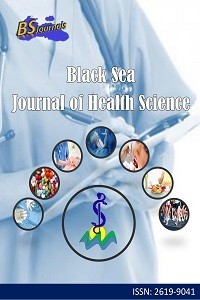The Turkish Version of the Self-Efficacy for Home Exercise Programs Scale Among Musculoskeletal Patients
SEHEPS-T, Self-efficacy, Exercise
The Turkish Version of the Self-Efficacy for Home Exercise Programs Scale Among Musculoskeletal Patients
SEHEPS-T, Self-efficacy, Exercise,
___
- Bandura A, Freeman W, Lightsey R. 1999. Self-efficacy: The exercise of control. Springer, New York, USA, 1th ed., pp. 591.
- Bozkurt N. 2009. Meme kanseri hastalarında egzersiz öz yeterlilik ölçeğinin Türkçe geçerlilik ve güvenirliğinin incelenmesi. Yüksek Lisans Tezi, Ege Üniversitesi, Sağlık Bilimleri Enstitüsü, İç Hastalıkları Hemşireliği Anabilim Dalı, Onkoloji Hemşireliği, İzmir, Türkiye, ss. 209.
- Carlson SA, Adams EK, Yang Z, Fulton JE. 2018. Percentage of deaths associated with inadequate physical activity in the United States. Prev Chronic Dis, 15: E38.
- Dong X, Liu Y, Wang A, Wang M. 2016. The psychometric properties of chinese version of SCI Exercise Self-Efficacy Scale in patients with stroke. Patient Prefer Adheren, 10: 1235.
- Hinkle D, Wiersma W, Jurs S. 2003. Determining power and sample size. Applied statistics for the behavioral science. Houghton Mifflin Company, Boston, MA, USA, 5th ed., pp. 297-330.
- Lee IM, Shiroma EJ, Lobelo F, Puska P, Blair SN, Katzmarzyk PT, Group LPASW. 2012. Effect of physical inactivity on major non-communicable diseases worldwide: an analysis of burden of disease and life expectancy. The Lancet, 380(9838): 219-229.
- Lewis BA, Marcus BH, Pate RR, Dunn AL. 2002. Psychosocial mediators of physical activity behavior among adults and children. American J Prevent Med, 23(2): 26-35.
- Locke EA. 1997. Self-efficacy: The exercise of control. Person Psychol, 50(3): 801.
- Mulaik SA. 2009. Foundations of factor analysis. Taylor & Francis, New York, USA, 2nd ed., pp. 548.
- Oliver K, Cronan T. 2002. Predictors of exercise behaviors among fibromyalgia patients. Prevent Med, 35(4): 383-389.
- Picha KJ, Howell DM. 2018. A model to increase rehabilitation adherence to home exercise programmes in patients with varying levels of self‐efficacy. Musculoskeletal Care, 16(1): 233-237.
- Picha KJ, Lester M, Heebner NR, Abt JP, Usher EL, Capilouto G, Uhl TL. 2019. The self-efficacy for home exercise programs scale: development and psychometric properties. J Orthop Sports Phys Ther, 49(9): 647-655.
- Tabachnick B, Fidell L. 2013. Using multivariate statistics. Pearson/Allyn and Bacon, Boston, MA, USA, 6th ed., pp. 980.
- Vlaeyen JW, Kole-Snijders AM, Boeren RG, Van Eek H. 1995. Fear of movement/(re) injury in chronic low back pain and its relation to behavioral performance. Pain, 62(3): 363-372.
- Vlaeyen JW, Linton SJ. 2000. Fear-avoidance and its consequences in chronic musculoskeletal pain: a state of the art. Pain, 85(3): 317-332.
- Wild D, Grove A, Martin M, Eremenco S, McElroy S, Verjee-Lorenz A, Erikson P. 2005. Principles of good practice for the translation and cultural adaptation process for patient-reported outcomes (PRO) measures: report of the ISPOR task force for translation and cultural adaptation. Value Health, 8(2): 94-104.
- Yilmaz ÖT, Yakut Y, Uygur F, Uluğ N. 2011. Tampa Kinezyofobi Ölçeği’nin Türkçe versiyonu ve test-tekrar test güvenirliği. Fizyoterapi Rehabil, 22(1): 44-49.
- Yayın Aralığı: Yılda 4 Sayı
- Başlangıç: 2018
- Yayıncı: Cem TIRINK
Use of Ventriculoperitoneal Shunt Reservoir as an Alternative to Lumbar Puncture, Case Series
Murat DUYAN, Hakan ÇAKIN, Nafis VURAL, Ali SARIDAŞ
A Scientometric Analysis on Cardiac Echinococcosis
Cemile UYAR, Emine Kübra DİNDAR DEMİRAY, Serpil OĞUZ MIZRAKÇI, Mustafa Serhat ŞAHİNOĞLU
Protez Enfeksiyonları Konulu Bilimsel Çıktıların Analizi
Cengiz TAŞKAYA, Buket BÜYÜKTURAN, Fatma KESKİNKILIÇ, Halil ALKAN, Öznur BÜYÜKTURAN
Hamide ŞİŞMAN, Refiye ÖZGEN, Dudu ALPTEKİN, Sevban ARSLAN
Biyolojik Tedaviler ve Tüberküloz: Bir Derleme Çalışması
İrem ŞAHİNOĞLU, Mustafa Serhat ŞAHİNOĞLU, Sevil ALKAN, Derya Çelebi AYDIN
Melek BİLGİN, Ahmet Burak ÇİFTÇİ, Mehmet BİLGİN
Mustafa Serhat ŞAHİNOĞLU, Sevil ALKAN
Pandemi Sürecinde Ebeveynlerin Koronavirüs Anksiyete Düzeyinin Ebeveyn Çocuk İlişkisine Etkisi
